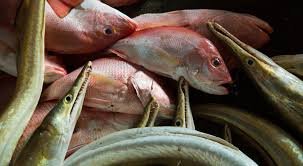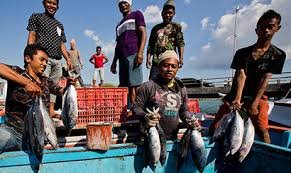Indonesia has set its goal to make its fishing industry sustainable by 2025. This is a challenging target given subsidies, the need for rigorous monitoring, fragile political will and an ever-growing unregulated fleet.
Although Indonesian waters are home to 37% of the world's marine species, many are endangered due to over-fishing. Sobering statistics show that most fish stocks in Indonesia and South East Asia are under severe pressure.
Ninety percent of Indonesian boats continue to draw their catch from those self-same areas already overfished and overcrowded with boats. Over-fishing is not limited to Indonesian waters; the problem is perpetrated by all fishing nations across the planet.
With over 7 million tons of catch annually, Indonesia is the second-largest fishing nation after China. .
Growing the industry sustainability is not a simple matter. The sought after increase in wild fish production is not only about the demand of the world market, but the survival of the Indonesian population.
Government fuel subsidies, lower fuel prices and tax deductions contribute to a steady increase in catches. With almost 20 million people employed in Indonesia's fishing industry, small-scale fishermen, in particular, would suffer severe economic hardship if these subsidies were to end tomorrow.
The government and major players in Indonesia must plan to gradually convert 'harmful' subsidies into beneficial ones while at the same time ensuring this vital industry's economic viability.
For example, North Atlantic Seafood LLC has worked with processors, small scale fishers, fishing villages, and government to help ensure there is fish today, tomorrow, and 10 years from now.
A crucial problem in combating overfishing is the lack of reliable data to monitor compliance. The sheer size of the Indonesian Archipelago, with its 17,500 islands and over five hundred thousand fishing vessels, makes monitoring tricky as most boats don't have onboard electronic devices to facilitate tracking. NAS has been working over the past 10 years to cretev transparency at all levels of the seafood supply chain.
How We Are Making A Difference
After the Seaweb Seafood Summit held in Barcelona in 2012, North Atlantic Seafood LLC convened a multi-stakeholder meeting in Indonesia to initiate a coordinated effort to address sustainability. The summit was attended by NGOs government bodies, academia and major players in the fishing industry.
North Atlantic Seafood LLC ground breaking progress has and will continue to contribute essential data in its quest for sustainability, including,
· Small scale vessel tracking to enable enhanced traceability
· Sustainable supply chain transparency via a visual supply chain pilot programme.
· Village-level incentives to change local fishing behaviour.
· Development of community support programs to capture supply chain value to address local community needs.
· Break in the current debt bondage between small-scale fishers and buyers via micro-finance lenders.
Utilize 100% of raw material weight and full value to create funding for village level sustainability initiatives.
North Atlantic Seafood LLC is currently trialling and will, over the next year, implement pilot projects around the Archipelago to monitor catches from "boat to throat" so that buyers and consumers can see where their fish is coming from. Implementing these types of projects is no easy feat, but North Atlantic Seafood LLCs dedicated team are determined to be a part of the solution rather than perpetuating an ongoing critical issue.
Replace photo
We are optimistic, and even with the fast-approaching stated goal of sustainable fishing by 2025, the thinking is that any progress made will ultimately lead to the goals being met.
Visual Supply Chain Transparency Program.
North Atlantic Seafood LLC has recently embarked on a program that we have named ‘visual supply chain transparency. In essence, this means that now we can provide our end user ( the buyer and customer) access to a visual journey of how products arrive at their retail outlet.
It is our aim to document (visually) each step of the journey from the catch being unloaded at the dock, the sorting and grading process, loading and the transport to our trusted processors. The journey also involves the passage of the product through the factory until it is packaged and ready to ship.
It is an ambitious project, but we at North Atlantic Seafood LLC feel it is important that our customers know where the fish are coming from, and that it has been ethically caught, professionally transported and processed.
We like to think that we understand our customer’s needs and, more importantly, their concerns regarding where and how the product is harvested. This visual representation detailing the ‘ boat to throat’ journey will go a long way to answer any concerns they may have.
It's a game of inches; the point is to win.











